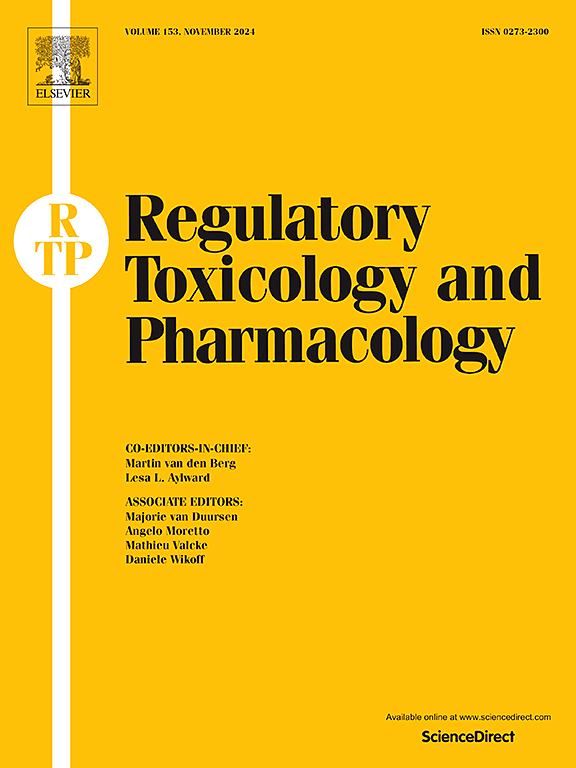Identifying human toxicodynamic variability: A systematic evidence map of the current knowledge
IF 3
4区 医学
Q1 MEDICINE, LEGAL
引用次数: 0
Abstract
Current chemical risk assessment uses a default uncertainty factor (UF) of 3.16 for toxicodynamic (TD) variability in humans. The objective was to create a systematic evidence map (SEM) of the human variability in TD by identifying and organizing the available empirical data to assess if a further refinement of the default UF of 3.16 for TD can be achieved. PubMed and Web of Science™ were searched from 2004 to 2023. Studies were screened according to the eligibility criteria. Inclusion criteria included studies, where TD could be separated from toxicokinetics (TK) to exclude an impact of TK on TD variability. The literature search retrieved 2408 studies. Manual screening identified 23 in vitro studies assessing human TD variability quantitively, of which only seven in vitro studies provided quantitative estimates of a TD variability factor. No in vivo study met the inclusion criteria. Several studies found TD UF of 3.16 not covering human variability; others did. However, the data were heterogeneous, and variability in Points of Departure (PODs) and methods used to estimate TD variability complicated comparisons across studies. A standardized approach for TDVFs determination is identified. This SEM underscores the scarcity of data assessing human variability in TD, while omitting the influence of TK.

识别人类毒性动力学变异性:当前知识的系统证据图
目前的化学品风险评估使用3.16的默认不确定性因子(UF)来评估人类的毒理学(TD)变异性。目标是通过识别和组织可用的经验数据来创建一个系统的证据图(SEM),以评估是否可以进一步改进TD的默认UF为3.16。检索了2004年至2023年的PubMed和Web of Science™。根据入选标准对研究进行筛选。纳入标准包括可以将TD与毒性动力学(TK)分离的研究,以排除TK对TD变异性的影响。文献检索检索到2408项研究。人工筛选确定了23项定量评估人类TD变异性的体外研究,其中只有7项体外研究提供了TD变异性因子的定量估计。没有体内研究符合纳入标准。几项研究发现,3.16的TD UF没有涵盖人类的可变性;别人做的。然而,数据是异质的,出发点(pod)的变异性和用于估计TD变异性的方法使研究间的比较复杂化。确定了tdvf测定的标准化方法。这一扫描电镜强调了评估人类TD变异性的数据的稀缺性,同时忽略了TK的影响。
本文章由计算机程序翻译,如有差异,请以英文原文为准。
求助全文
约1分钟内获得全文
求助全文
来源期刊
CiteScore
6.70
自引率
8.80%
发文量
147
审稿时长
58 days
期刊介绍:
Regulatory Toxicology and Pharmacology publishes peer reviewed articles that involve the generation, evaluation, and interpretation of experimental animal and human data that are of direct importance and relevance for regulatory authorities with respect to toxicological and pharmacological regulations in society. All peer-reviewed articles that are published should be devoted to improve the protection of human health and environment. Reviews and discussions are welcomed that address legal and/or regulatory decisions with respect to risk assessment and management of toxicological and pharmacological compounds on a scientific basis. It addresses an international readership of scientists, risk assessors and managers, and other professionals active in the field of human and environmental health.
Types of peer-reviewed articles published:
-Original research articles of relevance for regulatory aspects covering aspects including, but not limited to:
1.Factors influencing human sensitivity
2.Exposure science related to risk assessment
3.Alternative toxicological test methods
4.Frameworks for evaluation and integration of data in regulatory evaluations
5.Harmonization across regulatory agencies
6.Read-across methods and evaluations
-Contemporary Reviews on policy related Research issues
-Letters to the Editor
-Guest Editorials (by Invitation)

 求助内容:
求助内容: 应助结果提醒方式:
应助结果提醒方式:


